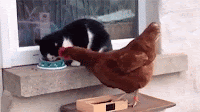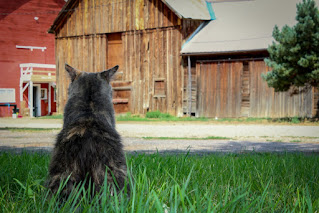Cats help keep insect numbers in check by hunting and eating them. While eating insects is not a vet-approved diet for a cat, they can generally do so with little or no trouble (learn more here). Which is a good thing, since a cat will chase down anything that flutters, crawls, flies, or skitters past it. Felines cannot clean up an infestation for you, but they may be able to keep numbers down enough to prevent one. And even one less fly is a blessing. According to this lady, flies are “sky raisins” to cats.
Barn cats are working animals, as opposed to family pets. They need to remain independent and tolerant of people, but not aggressive and hostile. A full-on feral cat will probably not make the best of barn cats and a housecat can’t be expected to do the work. You can sometimes bring a wild cat around to your way of thinking, but what you really need is a cat that is somewhere in between. Semi-wild if you will. Your best bet for acquiring this sort of cat is to adopt a feral one through an animal shelter. A feral cat that has been in a shelter will be at least somewhat conditioned to being around people and will have learned to see us as their food source. An even better adoption choice would be through a group that works with feral cats (this one focuses candidates for barn cats). A cat you receive from both kinds of places will have been fixed and vaccinated, greatly reducing the potential for disease as well as roaming and marking behavior.Acquiring a barn cat requires some commitment on your part. Although they are not pets, they are not wildlife either. You should be prepared to do what’s necessary to keep them healthy and fed. It may seem counter-intuitive to feed them if you want them to hunt mice and stuff, but it’s the thing to do. Not only is it compassionate, but you’ll also get better results from your little hunters. A well-fed cat will not only stick around, but it will also be able to spend its time patrolling its realm (aka recreational hunting) as opposed to the constant hunt for food which could lead them far away.
 Along with feeding them, you should provide shelter as well.
Like many of your other animals, they could be easy pickings for predators, so
they will need a safe and cozy place for them to hunker down at night. Feed
them at the end of the day in the location where you want them overnight and they
will quickly learn where they should be at nightfall. In the morning, let them
out when the chickens and everyone else goes out.
Along with feeding them, you should provide shelter as well.
Like many of your other animals, they could be easy pickings for predators, so
they will need a safe and cozy place for them to hunker down at night. Feed
them at the end of the day in the location where you want them overnight and they
will quickly learn where they should be at nightfall. In the morning, let them
out when the chickens and everyone else goes out.There are a few factors to consider that will work to keep your felines happy and at home. First of all, you should be in a rural, or at least semi-rural, area in order to keep your cats (and only your cats) on the job without interference. That being said, you may find a cat useful in town in a warehouse or nursery type of setup (with active monitoring). In truth, if your cats are spayed or neutered they will not be as attractive to or attracted by other cats. Secondly, when you adopt, you should take home a pair if you can. A cat that has a companion will be happier and more likely to stay put.
Bringing a barn cat into your world is an excellent way to give an animal a good life while keeping pests in check. They will love (maybe, they’re cats after all) and appreciate you for the chance, but your other animals will like them there as well. They like the
companionship of cats as much as people do - except for chickens. Chickens and cats have to learn to get along.

.












No comments:
Post a Comment